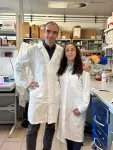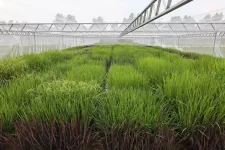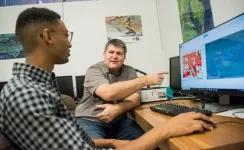(Press-News.org) Unseen and ongoing, thousands of times every second: to keep a complex organism like humans alive, an immense number of new cells must be continuously produced. Up close, each of these cell divisions is nothing short of a miracle. Within just a few hours, not only must the entire genome – billions of “letters” long – be replicated, but most other cellular structures must be doubled so that, in the end, two complete daughter cells can emerge.
Just before division, two complex protein structures, known as centrosomes, emerge, forming two opposing poles in the mother cell. These centrosomes grow long protein filaments, the spindle apparatus, that stretch toward the duplicated genetic material, latch onto it, and pull one copy of each chromosome to the opposing centrosome, evenly distributing the genetic material to the emerging daughter cells.
However, if this process fails, results can be catastrophic. The resulting cells, locked together like Siamese twins, would have twice as many chromosomes and centrosomes, making them unfit and prone to malignancy. Many cancer cells, for example, exhibit abnormal chromosome numbers and extra centrosome. Typically, before such defective cells can survive and grow, they arrest their cell cycle, or trigger their own destruction by an unknown mechanism.
Targeting the Cell’s Powerhouses
Researchers led by Andreas Villunger (Adjunct Principal Investigator at CeMM in Vienna and Professor at the Medical University of Innsbruck) and Luca Fava (Associate Professor at the University of Trento, Italy) have now clarified how this programmed cell death – known as apoptosis – is set off during faulty cell division. In their study, published in Science Advances (DOI:10.1126/sciadv.ado6607), they found that the presence of multiple centrosomes in a cell, a hallmark of disrupted division, activates a large protein complex called the PIDDosome.
The PIDDosome, in turn, activates the enzyme caspase-2, triggering two lethal pathways. First, it activates the protein BID, which directly destroys the mitochondria – the cell's powerhouses – leading to cell death. Simultaneously, caspase-2 activates the well-known tumor suppressor p53, which initiates additional signaling pathways that also result in cell death. This “double strike” ensures that cells with multiple centrosomes are eliminated, even under conditions when either BID or p53 are lacking or inhibited.
The researchers’ findings not only shed new light on these fundamental molecular mechanisms but also suggest potential applications in blood cancer treatment. Tumor cells are notorious for their rapid and uncontrolled division, and many cancer therapies aim to disrupt this process. Often, this leads to the formation and accumulation of multiple centrosomes in cancer cells, and the deadly effect of the PIDDosome could be harnessed to improve the efficacy of such treatments.
“By analyzing the BID and caspase-2 activity in cancer cells, we could potentially identify patients who are most likely to respond to drugs that interfere with cell division,” explains Andreas Villunger, highlighting the potential clinical application of their research. “Translating laboratory research into clinical practice is a lengthy and complex process. However, gaining deeper insights into the mechanisms of already approved drugs is essential to making therapies both more effective and less invasive”, adds Luca Fava, who believes that the research could help to layout the use of new combinations of existing drugs.
###
The Study “Caspase-2 kills cells with extra centrosomes” was published in Science Advances on October 30, 2024. DOI: 10.1126/sciadv.ado6607
Authors: Dario Rizzotto, Vincenza Vigorito, Patricia Rieder, Filip Gallob, Gian Mario Moretta, Claudia Soratroi, Joel S. Riley, Florian Bellutti, Stefano Li Veli, Alessia Mattivi, Michael Lohmüller, Sebastian Herzog, Beat C. Bornhauser, Etienne D. Jacotot; Andreas Villunger & Luca L. Fava
Funding: This study was supported by the Austrian Science Fund (FWF), the European Union (under ERC and NextGenerationEU), the Italian Association for Cancer Research (AIRC) and Telethon Foundation.
The CeMM Research Center for Molecular Medicine of the Austrian Academy of Sciences is an international, independent and interdisciplinary research institution for molecular medicine under the scientific direction of Giulio Superti-Furga. CeMM is oriented towards medical needs and integrates basic research and clinical expertise to develop innovative diagnostic and therapeutic approaches for precision medicine. Research focuses on cancer, inflammation, metabolic and immune disorders, rare diseases and aging. The Institute's research building is located on the campus of the Medical University and the Vienna General Hospital.
www.cemm.at
The University of Trento is one of the top research institutions in national and international rankings among Italian universities. It offers an ideal environment for study and research in numerous disciplinary areas. It is home to the Department of Computational and Integrative Biology (Dep.CIBIO), a leading academic institute in the field of biomedicine. In 2023 it was awarded the title ‘Department of Excellence’ by the Ministry of University and Research. The research programme of the CIBIO Department focuses on four main areas: Cancer Biology and Genomics, Cell and Molecular Biology, Microbiology and Synthetic Biology, and Neurobiology and Development.
www.cibio.unitn.it
For further information please contact:
Stefan Bernhardt
PR & Communications Manager CeMM
Phone +43-1/40160-70 056
sbernhardt@cemm.at
CeMM Research Center for Molecular Medicine of the Austrian Academy of Sciences
Lazarettgasse 14, AKH BT 25.3
1090 Vienna, Austria
Press Office and External Relations
Communication and External Relations Department
University of Trento
via Calepina, 14 - 38122 Trento (Italy)
tel. +39 0461 28 1131/1136/1249/1292
pressroom.unitn.it
END
Double strike against blood cancer
Induction of defective cell division could improve therapy
2024-10-30
ELSE PRESS RELEASES FROM THIS DATE:
Combining VR and non-invasive brain stimulation: a neurotechnology that boosts spatial memory without surgery
2024-10-30
As we age, it becomes more difficult to remember where things are—whether it’s recalling where we left the keys or where we parked the car. This spatial memory deteriorates further with the onset of dementia, a condition that someone in the world develops every three seconds, according to Alzheimer’s Disease International.
Researchers at two EPFL labs have joined forces to give a boost to spatial memory by creating a unique experimental setup that combines non-invasive deep-brain stimulation, virtual reality training, and fMRI imaging—all housed within Campus Biotech in Geneva. Published in Science Advances, the study demonstrates that targeted, ...
A rudimentary quantum network link between Dutch cities
2024-10-30
An international research team led by QuTech has demonstrated a network connection between quantum processors over metropolitan distances. Their result marks a key advance from early research networks in the lab towards a future quantum internet. The team developed fully independently operating nodes and integrated these with deployed optical internet fibre, enabling a 25 km quantum link. The researchers published their findings in Science Advances.
The internet allows people to share information (bits) globally. A future quantum internet will enable sharing quantum information (qubits) over a new type of network. Such qubits ...
Accounting for bias in medical data helps prevent AI from amplifying racial disparity
2024-10-30
Black patients are less likely than white patients to receive medical tests that doctors use to diagnose severe disease, such as sepsis, researchers at the University of Michigan have shown.
Because of the bias, some sick Black patients are assumed to be healthy in data used to train AI, and the resulting models likely underestimate illness in Black patients. But that doesn't mean the data is unusable—the same group developed a way to correct for this bias in data sets used to train AI.
These new insights are reported in a pair of studies: one published ...
MD Anderson Research Highlights for October 30, 2024
2024-10-30
HOUSTON ― The University of Texas MD Anderson Cancer Center’s Research Highlights showcases the latest breakthroughs in cancer care, research and prevention. These advances are made possible through seamless collaboration between MD Anderson’s world-leading clinicians and scientists, bringing discoveries from the lab to the clinic and back.
Epigenetic targets and genomic stem cell pathways drive adult hair regeneration
Retrotransposons are interspersed repeating sequences that make up over 40% of the human genome. Proper tissue regeneration requires ...
Three Baycrest leaders named 2024 Canada’s Most Powerful Women: WXN’s Top 100 Award winners
2024-10-30
Toronto, ON, October 30, 2024 – Three Baycrest leaders are among those named winners of Women Executive Network’s (WXN) prestigious 2024 Canada’s Most Powerful Women: Top 100 Awards, celebrating exceptional leadership and groundbreaking achievements that have meaningfully transformed their industries, companies, communities and country.
Dr. Allison Sekuler, President and Chief Scientist, Baycrest Academy for Research and Education and President and Chief Scientist, Centre for Aging + Brain Health Innovation, powered by Baycrest (CABHI)
Dr. ...
Scientists uncover new mechanism in plant cold sensing
2024-10-30
Cold damage is a major challenge in rice production, and identifying key gene modules in signaling pathways is a crucial means of addressing this issue. A Chinese research team has recently discovered a part of the plant’s cell membrane that helps plants sense when it's cold.
This cell membrane component, known as the COLD6-OSM1 module, triggers the production of a special molecule, 2',3'-cAMP, which helps plants sense and respond to low temperatures. This secondary messenger is a key upstream component that mediates the signaling pathway by directly responding to signals ...
Study shows natural regrowth of tropical forests has immense potential to address environmental concerns
2024-10-30
A new study in Nature finds that up to 215 million hectares of land (an area larger than Mexico) in humid tropical regions around the world has the potential to naturally regrow. That much forest could store 23.4 gigatons of carbon over 30 years and also have a significant impact on concerns like biodiversity loss and water quality. The study showed that more than half of the area with strong potential for regrowth was in five countries: Brazil, Mexico, Indonesia, China, and Colombia.
“Tree planting in degraded landscapes can be costly. By leveraging natural regeneration techniques, nations can meet their ...
After a heart attack, the heart signals to the brain to increase sleep to promote healing
2024-10-30
A heart attack can trigger a desire to get more sleep, allowing the heart to heal and reduce inflammation—and this happens because the heart sends special signals to the brain, according to a new Mount Sinai study. This research is the first to demonstrate how the heart and brain communicate with each other through the immune system to promote sleep and recovery after a major cardiovascular event.
The novel findings, published October 30 in Nature, emphasize the importance of increased sleep after a heart attack, and suggest that sufficient sleep should be a focus of post-heart-attack clinical management ...
Complexity of tumors revealed in 3D
2024-10-30
A new analysis led by researchers at Washington University School of Medicine in St. Louis has revealed detailed 3D maps of the internal structures of multiple tumor types. These cancer atlases reveal how different tumor cells — and the cells of a tumor’s surrounding environment — are organized, in 3D, and how that organization changes when a tumor spreads to other organs.
The detailed findings offer scientists valuable blueprints of tumors that could lead to new approaches to therapy and spark a new era in the field of cancer biology, according to the researchers.
The study is part of a group of 12 papers published Oct. 30 in the Nature suite of journals by members ...
Into the great wide open: How steppe pastoralist groups formed and transformed over time
2024-10-30
The wider Caucasus region, between the Black and the Caspian Seas, connects Europe, the Near East and Asia. It displays a huge geographic, ecological, economic, cultural, and linguistic range today, from the steppe zone in the north, the Caucasus mountains in the center, to the highlands of today’s Armenia, Georgia, Azerbaijan and Iran in the south. This diversity was no different in the past, where the archaeological record attests to many different influences from many surrounding regions.
“It is precisely this interface of different eco-geographic features ...
LAST 30 PRESS RELEASES:
New prostate cancer trial seeks to reduce toxicity without sacrificing efficacy
Geometry shapes life
A CRISPR screen reveals many previously unrecognized genes required for brain development and a new neurodevelopmental disorder
Hot flush treatment has anti-breast cancer activity, study finds
Securing AI systems against growing cybersecurity threats
Longest observation of an active solar region
Why nail-biting, procrastination and other self-sabotaging behaviors are rooted in survival instincts
Regional variations in mechanical properties of porcine leptomeninges
Artificial empathy in therapy and healthcare: advancements in interpersonal interaction technologies
Why some brains switch gears more efficiently than others
UVA’s Jundong Li wins ICDM’S 2025 Tao Li Award for data mining, machine learning
UVA’s low-power, high-performance computer power player Mircea Stan earns National Academy of Inventors fellowship
Not playing by the rules: USU researcher explores filamentous algae dynamics in rivers
Do our body clocks influence our risk of dementia?
Anthropologists offer new evidence of bipedalism in long-debated fossil discovery
Safer receipt paper from wood
Dosage-sensitive genes suggest no whole-genome duplications in ancestral angiosperm
First ancient human herpesvirus genomes document their deep history with humans
Why Some Bacteria Survive Antibiotics and How to Stop Them - New study reveals that bacteria can survive antibiotic treatment through two fundamentally different “shutdown modes”
UCLA study links scar healing to dangerous placenta condition
CHANGE-seq-BE finds off-target changes in the genome from base editors
The Journal of Nuclear Medicine Ahead-of-Print Tip Sheet: January 2, 2026
Delayed or absent first dose of measles, mumps, and rubella vaccination
Trends in US preterm birth rates by household income and race and ethnicity
Study identifies potential biomarker linked to progression and brain inflammation in multiple sclerosis
Many mothers in Norway do not show up for postnatal check-ups
Researchers want to find out why quick clay is so unstable
Superradiant spins show teamwork at the quantum scale
Cleveland Clinic Research links tumor bacteria to immunotherapy resistance in head and neck cancer
First Editorial of 2026: Resisting AI slop
[Press-News.org] Double strike against blood cancerInduction of defective cell division could improve therapy










